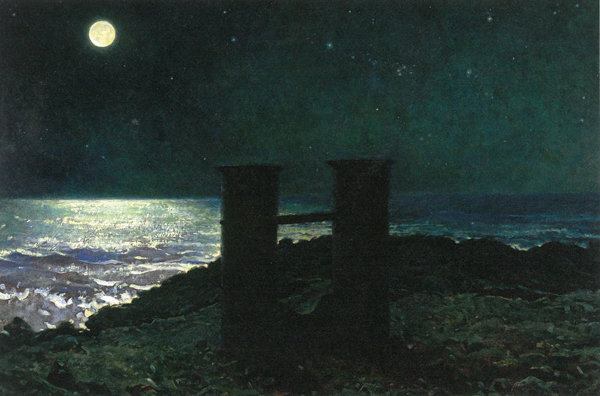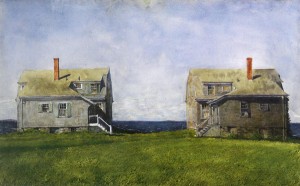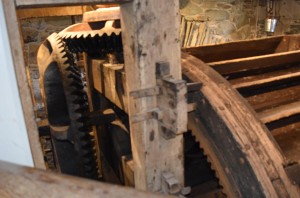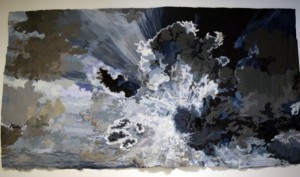
As Jerry Seinfeld says, buying fruit is a gamble—so are some art trips. In mid-July I headed to Providence, Rhode Island to take my art-philosophy Ph.D. orals. My husband, Dave, came along so he could eat tons of lobster and give me hugs. Happily, I passed – though going before academics is scary, even if you’ve studied hours and hours. Stay tuned as it’s going to be fun to report on my project: The Art of Winston Churchill.
Similar to writing court documents, academic writing requires an argument along with justification from the oracle of historical philosophers. This is different from creative writing which encourages the artist to leave gaps so the reader can do some thinking too. Well, my 30-page pre-dissertation teaser was like making cookies. I spent last winter measuring the sugar and dropping in broken eggs. I even folded in chocolate chips. I was so engrossed I forgot to turn on the metaphorical oven. In academic terms, I didn’t explain how I was going to accomplish my argument enough. So it’s back to the drawing board this August. Anyway, after passing my orals I had time to take in some art, observing that others who create aren’t always at their finish lines, and that’s OK .

Five miles north of downtown Providence, RI is the Slater Mill. Founded in 1793 by the abolitionist Moses Brown, it was one of the first water-powered cotton spinning mills in North America. The Blackstone River was dammed to turn a huge 16,000 pound waterwheel, still visible under the machine shop – imagine seven Chevy Suburbans stacked up like Fig Newtons. Above the wheel, three foot wide stone walls make up the mill’s fabricating workshop.
The water wheel turned iron cogs sending energy upstairs to a shaft which spanned the entire workroom. The shaft held graduated disks –think donuts on a dowel. Leather belts resembling mobius strips could be loosened or tightened and shifted onto these small or large cogs which controlled the speed/tension of drill presses and lathes that made parts for the spinning machines found in the adjacent clapboard building. Animal fat used to grease gears was as nauseating to workers as the water-wheel vibration, not to mention the dead air from shut windows or the absence of lighting fixtures. Next door in the yellow painted spinning mill, the lint from processing the cotton batting into thread caused lung disorders too. There was no workman’s compensation and using young children who could dart under dangerously moving machinery was thought to be more humane and cheaper than slave labor. Contemporary woodworkers will observe how little has changed in the design of sanding drums and planers.
Wanting to engage, I looked to my New England heritage. I imagined great-grandfather Fred Wellington and his forbearers who were farmers in nearby North Oxford, Mass; maybe they sold animal fat to Slater Mill.

Of note: the buildings are slim, long and compact. Parsimonious Yankee entrepreneurs were competing with foreign goods and wanted every “bang for their buck.” In spite of long hours, the pay was more reliable than farming the Northeast’s problematic climate and rocky soil. In the nineties, when drawing at the New Bedford Whaling Museum for my BFA project, I was distracted by visitors asking their guide if figure-heads appeared on the bows of whaling vessels. The docent quipped, “hell no, do you think those Yankees would spend money on frivolity!”
Mill towns had occasional strikes with bloody rioting. Times have changed as today a twenty-foot inflatable rat, a trope for workers protesting pay and benefit reductions, hardly startles those walking past New York’s Saks Fifth Avenue. Slater Mill is a great destination to envision a bygone era; right or wrong, it’s part of our American experiment. Keeping Slater Mill Museum funded is a continual headache. Here are a few suggestions. Visitors would benefit from a brochure as it’s hard to absorb all that the docent imparts. Slater’s gift shop might try selling t-shirts and tote bags with a more sophisticated/minimal logo. You don’t have to mimic MoMA’s Bauhaus designs, as Paul Revere’s artistry or even the Shakers understood that ‘less is more’ for household goods. Tea and a crumpet outside under umbrella-tables would allow museum goers to digest the history that ensued throughout the decades.
On the way to catch my plane back to Anchorage, I stopped at the Boston Museum of Fine Arts to see the Jamie Wyeth Retrospective (until December 28, 2014). Jamie is an artist who never quite seems to know where he’s going or whom he is pleasing. It’s not that he is not a genius painter; his portraiture and barnyard animals are spot on. And he’s less stiff with pencil renderings and brushstrokes than Andrew, his dad, thus delving into more of the unconscious. Jamie is also less romantically illustrative than grandpa N.C. Wyeth, the Scribner god of Stevenson’s Treasure Island and Kidnapped.

Jamie Wyeth left traditional schooling after sixth grade and was tutored at home in the mornings, taking art lessons from aunt Carolyn afternoons. Sequestering him from the real world including a college art education assured that the Wyeth family aesthetic tradition would continue. As a result Jamie’s work has a feeling of Hopper isolation in spite of breaking away to work with Andy Warhol or sketching for the famed Watergate hearings. Maybe that’s why he donned a carved Halloween pumpkin for his self-portrait—a bit Darth Vader spooky.
Jamie executes in realism, abstraction and the fanciful searching for identity in a family of defined giants. He has inherited the Wyeth attention to detail, even using calipers to measure body parts. The dancer Rudolph Nureyev remarked when being painted, “you could make me a suit.” Yet the artist’s unfinished sketch of the dancer complete with facial clown-white has a relaxed, deeply pensive, Toulouse Lautrec quality, and feels far more natural than Jamie’s measure of the man standing before his ballet bars. But Jamie’s women who drive horse-drawn carriages through forests or his flying pumpkins resembling hot air balloons fall short of grandpa NC’s fantasy or dad Andrew’s reserved realism.
Take heart, Wyeth succeeds with Twin Houses (1969). Two New England Dutch colonials worn by years of dwelling seaside appear to be conversing like two old chums on a park bench. Then there’s Moon Landing (1969). Jamie was invited to render Cape Kennedy space launches. In one sketch he adds a bicycle as a humble reminder that it all began on two wheels at Kitty Hawk. Moon Landing has a sublime quality similar to the German Romantic Caspar David Friedrich. Jamie’s seascape is not a trite recreation of Armstrong’s ‘one giant leap for mankind.’ He replaces Friedrich’s lonely frock-coated gentleman who overlooks a frothy sea with two oil drums (make-shift fencing) metaphorically watching the moon’s watery reflection. From time immemorial, humanity has viewed the moon from earth. It has been Alfred Noyes’ ‘ghostly galleon tossed upon cloudy seas’ and not some ego trip between super powers.
The MFA is a world class institution but their eateries need revamping. Husband Dave and I chose the basic café, hoping to save time. Sadly the soup and chicken fingers along with the lack of table bussing was on par with an elementary school cafeteria.
Boston’s Logan Airport is a stone’s throw from the Institute of Contemporary Art. Aesthetic encounters can be grabbed right up to boarding your plane with a convenient water taxi from the airport to the ICA. We managed to catch the Jim Hodges exhibition (until September 1, 2014). Hodges, an installation artist, seems to borrow and regurgitate his own renditions. Lighting fixtures play homage to Felix Gonzales-Torres, plywood walls covered in a golden abstract reference Richard Serra’s rusty mazes, while glass-enclosed flowers allude to Jeff Koons and a light box that visitors enter felt like a recreation of a James Terrell skyspace. Hodges’ massive wall piece made of found jeans resembles a Renaissance biblical sky-scape. Most contemporary sewn art is made by women who want to elevate needlework beyond mere craft. Here Hodges cut and assembled the pieces but had a seamstress bind and stitch, much like a tenement tailor shop where women sewed what was cut by men. Although the piece is magnificent not much social progress can be deduced.
As I flew home to revamp my PhD-thesis statement, I mused about other artists and aesthetic destinations, realizing no one gets it completely right.
During my week in Providence, Dave and I experienced great restaurants. VIA Italian Table, Worcester Mass., wrote congratulations with chocolate sauce on my cannoli. The swordfish at the Waterman Grille rivalled their Seekonk River view. At Pot au Feu, we dined with dear old friends over onion soup and quiche. But after two hours of Ph.D. orals reminiscent of some Cold War flick where the alleged spy gets threatened with lighted cigarette butts, I headed for a plate of Friendly’s frozen fried clams. I confess, they aren’t very clammy and probably haven’t seen an ocean in eons, but they were really delicious.
Jamie Wyeth and Jim Hodges catalogs are available on Amazon. Slater Mill information is also on-line.




